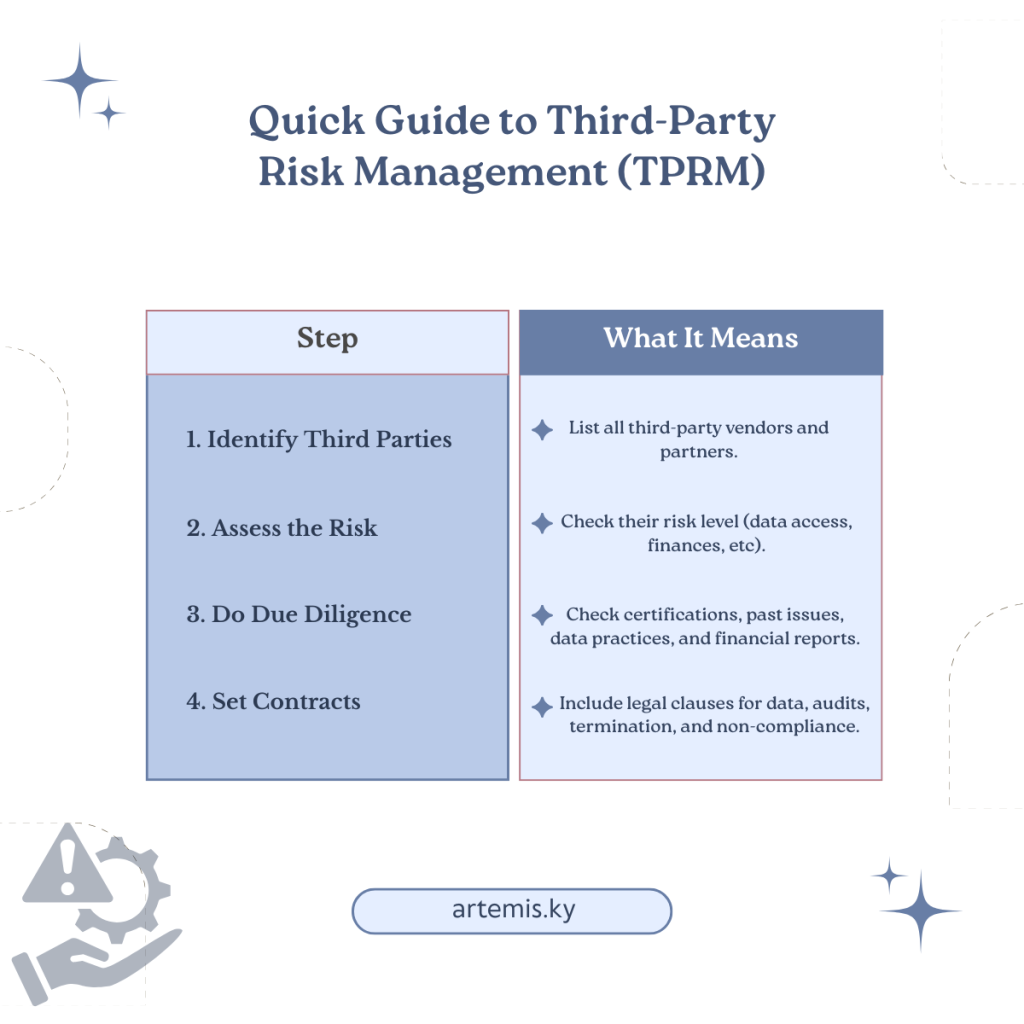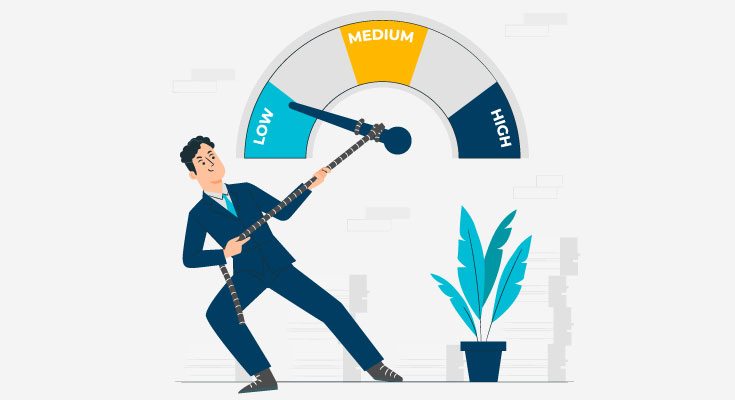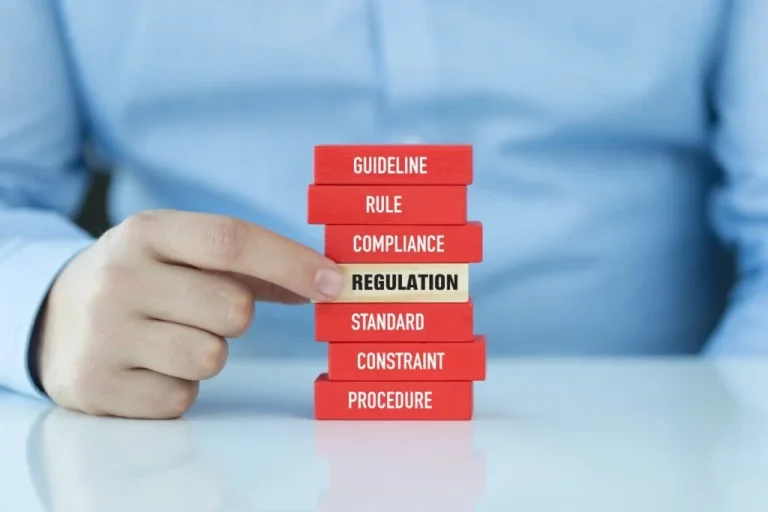Table of Contents
Third-party risk management is more than a checklist—it’s how smart businesses protect themselves from vendor failures, data breaches, and hidden risks.
Let’s be real—running a business is already tough enough without worrying about what your vendors are up to behind the scenes. But if you’re anything like me, you’ve probably learned (maybe the hard way) that one sloppy third-party mistake can cost you big time. I used to think, “Well, I trust them. They seem legit.” Until I realized that trust without verification is a risk I couldn’t afford anymore. That’s when I dove into the world of third-party risk management—and wow, it changed the way I do business.
In this guide, I’m breaking down what third-party risk management actually means (without the legal mumbo jumbo), why it’s more important than ever, and how to protect your business from getting blindsided by someone else’s mess.
Whether you’re a startup founder, a growing business, or just trying to keep your sanity while scaling—you’ll want to stick around for this one.
What Is Third-Party Risk Management (TPRM)?

Third-party risk management is just a fancy way of saying: “Let’s make sure the people we work with don’t mess things up for us.”
It’s the process of spotting and managing risks that come from the outside—like vendors, suppliers, contractors, or consultants. Because here’s the thing: you can have strong security, solid policies, and all the right systems… but if your vendor doesn’t? Boom. You’re exposed.
It’s like locking your front door but leaving the window open for someone else to climb in.
That’s where TPRM support from experts comes in—to protect your business from risks you didn’t even know you were letting in.
- Outsourced doesn’t mean out of risk — You’re still responsible for what third parties do on your behalf.
- Vendors have access to your data, systems, or customers — if they get breached, you could too.
- Small issues with partners can cause big damage — like legal trouble, lost trust, or stalled operations.
Why Is Third-Party Risk Management So Important?
We’re living in a connected world. You might be using cloud platforms, hiring remote support teams, or outsourcing IT work—maybe even all three.
Each third-party relationship adds value, but it also adds risk.
Here’s why having a system to manage those risks is a must:
- Avoid Cyberattacks: Many hackers sneak in through third-party software or services.
- Stay Compliant: Laws like GDPR, HIPAA, and CCPA require you to control who touches your data.
- Protect Your Reputation: If a vendor messes up, people won’t blame them—they’ll blame you.
- Keep Things Running Smoothly: If your main supplier goes down, your whole operation can stall.
Want help staying compliant with Cayman regulations while outsourcing smartly? Artemis Advisory’s risk and compliance services have you covered.
What Kinds of Risks Come from Third Parties?

Credit: diro.io
Not all risks look the same. Some are technical. And some are financial. Some just give you a PR nightmare. Here are the big ones to keep on your radar:
1. Cybersecurity Risk
If a vendor has weak security and gets hacked, your systems could be next.
2. Legal & Compliance Risk
If your vendor doesn’t follow the law, your business could end up paying the price—especially in finance or healthcare.
3. Reputational Risk
If your vendor is caught doing shady stuff (like data leaks or bad labor practices), your brand takes a hit, not just theirs.
4. Operational Risk
What if your shipping partner goes bankrupt? Or your software vendor stops updating their tool? That’s a big problem for your day-to-day.
5. Financial Risk
Vendors hiding debt or involved in fraud can cause delays, overspending, or total project failure.
How to Manage Third-Party Risks: Step by Step

Credit: mycoitracking.com
Let’s walk through a simple process that works—even if you’re not a giant corporation.
📝 Step 1: Make a List
Write down every third party you work with. Think: software providers, contractors, suppliers, consultants—even freelancers.
⚠️ Step 2: Check the Risk Level
Not all third parties are equal. Ask yourself:
- Do they handle sensitive data?
- Can they access your systems?
- Are they financially stable?
- Have they had issues in the past?
Use these answers to rate each vendor as low, medium, or high risk.
🔍 Step 3: Do Some Homework
Before signing a contract, do your due diligence:
- Do they have certifications like ISO 27001 or SOC 2?
- Have they been in legal trouble?
- Can they prove financial stability?
- What do other companies say about them?
- How do they handle customer data?
Need help with due diligence and vendor audits? Risk management consulting from Artemis can handle it for you.
📄 Step 4: Get It in Writing
Set expectations clearly in the contract:
- Add data privacy clauses
- Include audit rights
- Define what happens if they mess up
- Have an exit clause ready
🔁 Step 5: Don’t Just “Set It and Forget It”
Check in regularly. Run performance reviews, security checks, or compliance audits depending on the risk level.
🛑 Step 6: Always Have a Plan B
If a vendor fails or becomes a liability, you need a smooth exit. Always have a backup or contingency plan ready.
Tools That Can Help (So You Don’t Lose Your Mind)
Managing third-party risks manually is doable… until it’s not. As your list of vendors grows, these tools can save time and stress:
- GRC Platforms: (Governance, Risk & Compliance) like ServiceNow, LogicGate
- TPRM Software: OneTrust, Aravo, Venminder
- Security Rating Services: BitSight, SecurityScorecard
Not sure what tool fits your business? Get strategic risk management help tailored to your operations and budget.
Who’s Responsible for TPRM?

Credit: veriforce.com
Short answer? Everyone.
Long answer:
- Procurement checks vendor risks before bringing them in.
- Legal ensures contracts are tight and protect your company.
- IT/Security looks out for data risks and access issues.
- Compliance/risk officers build and oversee the whole system.
If you’re a small business, you might not have separate departments—but that doesn’t mean you skip it. Even a checklist can go a long way. And if it feels overwhelming, Artemis offers fractional risk officer services—so you get expert support only when you need it.
Why Is It Worth It?
Still thinking this sounds like too much work? Here’s what a solid TPRM program gives you:
-
✅ Stronger security
-
✅ Fewer surprises during audits
-
✅ Better business continuity
-
✅ Less finger-pointing when things go wrong
-
✅ More trust from clients and partners
In short, it protects your business and builds your reputation.
Mistakes to Avoid (Seriously)
-
❌ Only checking vendors once and never again
-
❌ Ignoring small vendors because “they’re not important”
-
❌ Taking a vendor’s word for it without proof
-
❌ No backup plan if a vendor fails
-
❌ Contracts without clear risk or data terms
Remember: You can outsource the task—but not the risk.
The Bottom Line
Summing up, third-party risk management service isn’t a one-time project. It’s a mindset. A smart habit. A shield.
As businesses become more digital and more connected, the risks grow too. That’s why knowing who you’re working with, how they operate, and what they could impact is more important than ever.
And if you want help building that shield? Talk to the team at Artemis Advisory—your Cayman-based risk experts who help businesses grow safely and stay compliant.FAQs: Quick and Simple
Q1: What is third-party risk management in simple words?
It’s checking and managing the risks that come from vendors or outside partners.
Q2: What are examples of third-party risk?
Cyberattacks through vendors, delivery delays, legal issues, bad press, or vendors running out of money.
Q3: Is this legally required?
In some industries, yes. If you’re in finance, healthcare, or anything involving personal data, you’re probably required to do it.
Q4: How often should I check on vendors?
At least once a year. High-risk vendors should be checked more often.





